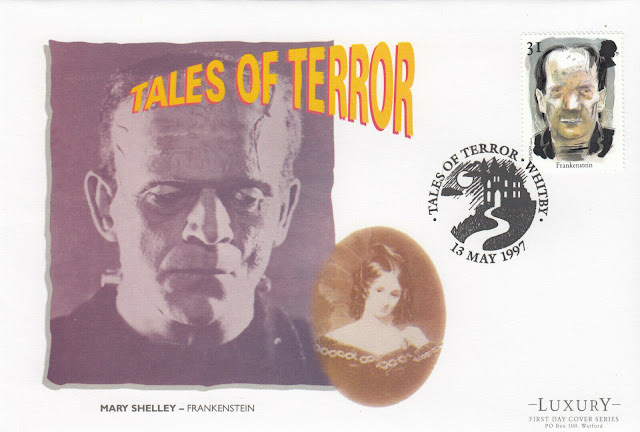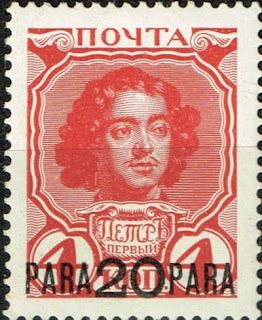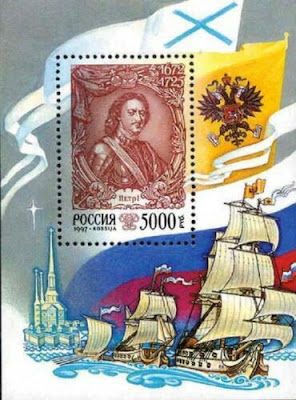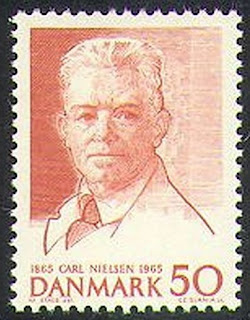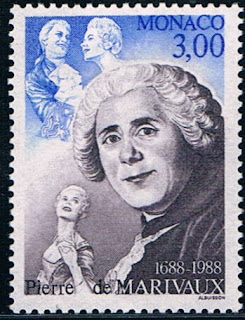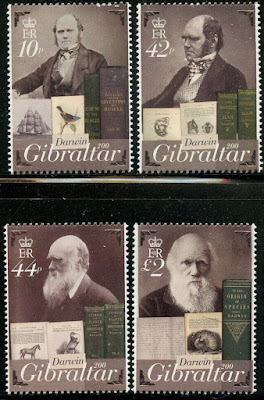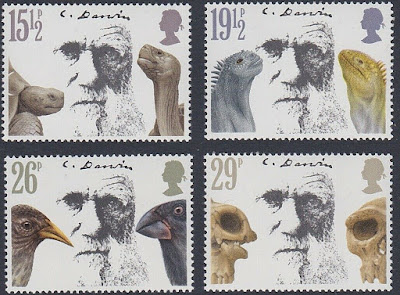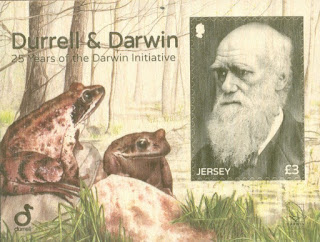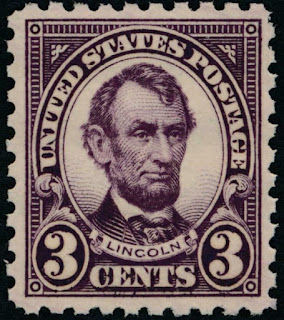- Founded Stjärnsunds manufakturverk in södra Dalarna during 1700.
- Reinvented the Cardan joint under the name of "Polhem knot" (Swedish: Polhemknut) independently of Gerolamo Cardano, the pioneer inventor.
- Organized machinery into a "mechanical alphabet" and provided examples of such. Of 80 models carved in wood, 32 are still in the collections of the National Museum of Science and Technology (Swedish:Tekniska Museet) in Stockholm. Another 13 models of the "mechanical alphabet" are to be found in the Falun Mining Museum, Sweden.
Sunday, August 30, 2020
August 30th in stamps Mary Shelley, Christopher Polhem, Jacobus Henricus van 't Hoff
Tuesday, June 09, 2020
June 9th in stamps Peter the Great, Bertha von Suttner, Carl Nielsen, Charles Dickens, Cole Porter
1672 Born: Peter the Great, Russian emperor (d. 1725)
Peter the Great (Peter I or Peter Alexeyevich 9 June 1672 – 8 February 1725) ruled the Tsardom of Russia and later the Russian Empire from 7 May 1682 until his death in 1725, jointly ruling before 1696 with his elder half-brother, Ivan V. Through a number of successful wars, he expanded the Tsardom into a much larger empire that became a major European power and also laid the groundwork for the Russian navy after capturing ports at Azov and the Baltic Sea. He led a cultural revolution that replaced some of the traditionalist and medieval social and political systems with ones that were modern, scientific, Westernised and based on the Enlightenment. Peter's reforms had a lasting impact on Russia, and many institutions of the Russian government trace their origins to his reign. He is also known for founding and developing the city of Saint Petersburg, which remained the capital of Russia until 1917.
Russian stamps depicting Peter the Great
1843 Born: Bertha von Suttner, Austrian journalist and author, Nobel Prize laureate (d. 1914)
Bertha Felicitas Sophie Freifrau von Suttner (9 June 1843 – 21 June 1914) was an Austrian-Bohemian pacifist and novelist. In 1905, she became the second female Nobel laureate (after Marie Curie in 1903), the first woman to be awarded the Nobel Peace Prize, and the first Austrian laureate.
In 1889 Suttner became a leading figure in the peace movement with the publication of her pacifist novel, Die Waffen nieder! (Lay Down Your Arms!), which made her one of the leading figures of the Austrian peace movement. The book was published in 37 editions and translated into 12 languages. She witnessed the foundation of the Inter-Parliamentary Union and called for the establishment of the Austrian Gesellschaft der Friedensfreunde pacifist organisation in an 1891 Neue Freie Presse editorial. Suttner became chairwoman and also founded the German Peace Society the next year. She became known internationally as the editor of the international pacifist journal Die Waffen nieder!, named after her book, from 1892 to 1899. In 1897 she presented Emperor Franz Joseph I of Austria with a list of signatures urging the establishment of an International Court of Justice and took part in the First Hague Convention in 1899 with the help of Theodor Herzl, who paid for her trip as a correspondent of the Zionist newspaper, Die Welt.
Upon her husband's death in 1902, Suttner had to sell Harmannsdorf Castle and moved back to Vienna. In 1904 she addressed the International Congress of Women in Berlin and for seven months travelled around the United States, attending a universal peace congress in Boston and meeting President Theodore Roosevelt.
Though her personal contact with Alfred Nobel had been brief, she corresponded with him until his death in 1896, and it is believed that she was a major influence on his decision to include a peace prize among those prizes provided in his will, which she was awarded in the fifth term on 10 December 1905. The presentation took place on 18 April 1906 in Kristiania.
German and Austrian stamps depicting Bertha von Suttner
1865 Born: Carl Nielsen, Danish violinist, composer, and conductor (d. 1931)
Carl August Nielsen (9 June 1865 – 3 October 1931) was a Danish composer, conductor and violinist, widely recognized as his country's most prominent composer.
Brought up by poor yet musically talented parents on the island of Funen, he demonstrated his musical abilities at an early age. He initially played in a military band before attending the Royal Danish Academy of Music in Copenhagen from 1884 until December 1886. He premiered his Op. 1, Suite for Strings, in 1888, at the age of 23. The following year, Nielsen began a 16-year stint as a second violinist in the Royal Danish Orchestra under the conductor Johan Svendsen, during which he played in Giuseppe Verdi's Falstaff and Otello at their Danish premieres. In 1916, he took a post teaching at the Royal Danish Academy and continued to work there until his death.
Although his symphonies, concertos and choral music are now internationally acclaimed, Nielsen's career and personal life were marked by many difficulties, often reflected in his music. The works he composed between 1897 and 1904 are sometimes ascribed to his "psychological" period, resulting mainly from a turbulent marriage with the sculptor Anne Marie Brodersen. Nielsen is especially noted for his six symphonies, his Wind Quintet and his concertos for violin, flute and clarinet. In Denmark, his opera Maskarade and many of his songs have become an integral part of the national heritage. His early music was inspired by composers such as Brahms and Grieg, but he soon developed his own style, first experimenting with progressive tonality and later diverging even more radically from the standards of composition still common at the time. Nielsen's sixth and final symphony, Sinfonia semplice, was written in 1924–25. He died from a heart attack six years later, and is buried in Vestre Cemetery, Copenhagen.
Nielsen maintained the reputation of a musical outsider during his lifetime, both in his own country and internationally. It was only later that his works firmly entered the international repertoire, accelerating in popularity from the 1960s through Leonard Bernstein and others. In Denmark, Nielsen's reputation was sealed in 2006 when three of his compositions were listed by the Ministry of Culture amongst the twelve greatest pieces of Danish music. For many years, he appeared on the Danish hundred-kroner banknote. The Carl Nielsen Museum in Odense documents his life and that of his wife. Between 1994 and 2009 the Royal Danish Library, sponsored by the Danish government, completed the Carl Nielsen Edition, freely available online, containing background information and sheet music for all of Nielsen's works, many of which had not been previously published.
Danish stamp depicting Carl Nielsen
1870 Died: Charles Dickens, English novelist and critic (b. 1812)
Charles John Huffam Dickens (7 February 1812 – 9 June 1870) was an English writer and social critic. He created some of the world's best-known fictional characters and is regarded by many as the greatest novelist of the Victorian era. His works enjoyed unprecedented popularity during his lifetime, and by the 20th century, critics and scholars had recognised him as a literary genius. His novels and short stories are still widely read today.
Born in Portsmouth, Dickens left school to work in a factory when his father was incarcerated in a debtors' prison. Despite his lack of formal education, he edited a weekly journal for 20 years, wrote 15 novels, five novellas, hundreds of short stories and non-fiction articles, lectured and performed readings extensively, was an indefatigable letter writer, and campaigned vigorously for children's rights, education, and other social reforms.
Dickens's literary success began with the 1836 serial publication of The Pickwick Papers. Within a few years he had become an international literary celebrity, famous for his humour, satire, and keen observation of character and society. His novels, most published in monthly or weekly instalments, pioneered the serial publication of narrative fiction, which became the dominant Victorian mode for novel publication. Cliffhanger endings in his serial publications kept readers in suspense. The installment format allowed Dickens to evaluate his audience's reaction, and he often modified his plot and character development based on such feedback. For example, when his wife's chiropodist expressed distress at the way Miss Mowcher in David Copperfield seemed to reflect her disabilities, Dickens improved the character with positive features. His plots were carefully constructed, and he often wove elements from topical events into his narratives. Masses of the illiterate poor chipped in ha'pennies to have each new monthly episode read to them, opening up and inspiring a new class of readers.
His 1843 novella A Christmas Carol remains especially popular and continues to inspire adaptations in every artistic genre. Oliver Twist and Great Expectations are also frequently adapted and, like many of his novels, evoke images of early Victorian London. His 1859 novel A Tale of Two Cities (set in London and Paris) is his best-known work of historical fiction. The most famous celebrity of his era, he undertook, in response to public demand, a series of public reading tours in the later part of his career. Dickens has been praised by many of his fellow writers—from Leo Tolstoy to George Orwell, G. K. Chesterton, and Tom Wolfe—for his realism, comedy, prose style, unique characterisations, and social criticism. However, Oscar Wilde, Henry James, and Virginia Woolf complained of a lack of psychological depth, loose writing, and a vein of sentimentalism.
The term Dickensian is used to describe something that is reminiscent of Dickens and his writings, such as poor social conditions or comically repulsive characters.
Stamps from Great Britain depicting Charles Dickens' works
1891 Born: Cole Porter, American composer and songwriter (d. 1964)
Cole Albert Porter (June 9, 1891 – October 15, 1964) was an American composer and songwriter. Many of his songs became standards noted for their witty, urbane lyrics, and many of his scores found success on Broadway and in film.
Born to a wealthy family in Indiana, Porter defied his grandfather's wishes and took up music as a profession. Classically trained, he was drawn to musical theatre. After a slow start, he began to achieve success in the 1920s, and by the 1930s he was one of the major songwriters for the Broadway musical stage. Unlike many successful Broadway composers, Porter wrote the lyrics as well as the music for his songs. After a serious horseback riding accident in 1937, Porter was left disabled and in constant pain, but he continued to work. His shows of the early 1940s did not contain the lasting hits of his best work of the 1920s and 1930s, but in 1948 he made a triumphant comeback with his most successful musical, Kiss Me, Kate. It won the first Tony Award for Best Musical.
Porter's other musicals include Fifty Million Frenchmen, DuBarry Was a Lady, Anything Goes, Can-Can and Silk Stockings. His numerous hit songs include "Night and Day", "Begin the Beguine", "I Get a Kick Out of You", "Well, Did You Evah!", "I've Got You Under My Skin", "My Heart Belongs to Daddy" and "You're the Top". He also composed scores for films from the 1930s to the 1950s, including Born to Dance (1936), which featured the song "You'd Be So Easy to Love"; Rosalie (1937), which featured "In the Still of the Night"; High Society (1956), which included "True Love"; and Les Girls (1957).
US stamp issued in 1991 depicting Cole Porter
Wednesday, February 12, 2020
February 12th in stamps Marivaux, Darwin, Lincoln, Renault
1763 Died: Pierre de Marivaux, French author and playwright (b. 1688)
Pierre Carlet de Chamblain de Marivaux (4 February 1688 – 12 February 1763), commonly referred to as Marivaux, was a French novelist and dramatist.
He is considered one of the most important French playwrights of the 18th century, writing numerous comedies for the Comédie-Française and the Comédie-Italienne of Paris. His most important works are Le Triomphe de l'amour, Le Jeu de l'amour et du hasard and Les Fausses Confidences. He also published a number of essays and two important but unfinished novels, La Vie de Marianne and Le Paysan parvenu.
Stamps from Monaco and France depicting de Marivaux
Charles Robert Darwin (12 February 1809 – 19 April 1882) was an English naturalist, geologist and biologist, best known for his contributions to the science of evolution. His proposition that all species of life have descended over time from common ancestors is now widely accepted, and considered a foundational concept in science. In a joint publication with Alfred Russel Wallace, he introduced his scientific theory that this branching pattern of evolution resulted from a process that he called natural selection, in which the struggle for existence has a similar effect to the artificial selection involved in selective breeding. Darwin has been described as one of the most influential figures in human history, and he was honoured by burial in Westminster Abbey.
Darwin published his theory of evolution with compelling evidence in his 1859 book On the Origin of Species. By the 1870s, the scientific community and a majority of the educated public had accepted evolution as a fact. However, many favoured competing explanations which gave only a minor role to natural selection, and it was not until the emergence of the modern evolutionary synthesis from the 1930s to the 1950s that a broad consensus developed in which natural selection was the basic mechanism of evolution. Darwin's scientific discovery is the unifying theory of the life sciences, explaining the diversity of life.
Darwin's early interest in nature led him to neglect his medical education at the University of Edinburgh; instead, he helped to investigate marine invertebrates. Studies at the University of Cambridge (Christ's College) encouraged his passion for natural science. His five-year voyage on HMS Beagle established him as an eminent geologist whose observations and theories supported Charles Lyell's conception of gradual geological change, and publication of his journal of the voyage made him famous as a popular author.
Puzzled by the geographical distribution of wildlife and fossils he collected on the voyage, Darwin began detailed investigations, and in 1838 conceived his theory of natural selection. Although he discussed his ideas with several naturalists, he needed time for extensive research and his geological work had priority. He was writing up his theory in 1858 when Alfred Russel Wallace sent him an essay that described the same idea, prompting immediate joint publication of both of their theories. Darwin's work established evolutionary descent with modification as the dominant scientific explanation of diversification in nature. In 1871 he examined human evolution and sexual selection in The Descent of Man, and Selection in Relation to Sex, followed by The Expression of the Emotions in Man and Animals (1872). His research on plants was published in a series of books, and in his final book, The Formation of Vegetable Mould, through the Actions of Worms (1881), he examined earthworms and their effect on soil.
Stamps from Gibraltar, Great Britain, Jersey and Tuvalu commemorating Darwin
1809 Born: Abraham Lincoln, American lawyer and politician, 16th President of the United States (assassinated in 1865)
Abraham Lincoln (February 12, 1809 – April 15, 1865) was an American statesman and lawyer who served as the 16th president of the United States from March 1861 until his assassination in April 1865. Lincoln led the nation through the American Civil War, its bloodiest war and its greatest moral, constitutional, and political crisis. He preserved the Union, abolished slavery, strengthened the federal government, and modernized the U.S. economy.
Born in Kentucky, Lincoln grew up on the frontier in a poor family. Self-educated, he became a lawyer, Whig Party leader, Illinois state legislator and Congressman. In 1849, he left government to resume his law practice, but angered by the success of Democrats in opening the prairie lands to slavery, reentered politics in 1854. He became a leader in the new Republican Party and gained national attention in 1858 for debating national Democratic leader Stephen A. Douglas in the 1858 Illinois Senate campaign. He then ran for President in 1860, sweeping the North and winning. Southern pro-slavery elements took his win as proof that the North was rejecting the constitutional rights of Southern states to practice slavery. They began the process of seceding from the union. To secure its independence, the new Confederate States of America fired on Fort Sumter, one of the few U.S. forts in the South. Lincoln called up volunteers and militia to suppress the rebellion and restore the Union.
As the leader of the moderate faction of the Republican Party, Lincoln confronted Radical Republicans, who demanded harsher treatment of the South; War Democrats, who rallied a large faction of former opponents into his camp; anti-war Democrats (called Copperheads), who despised him; and irreconcilable secessionists, who plotted his assassination. Lincoln fought the factions by pitting them against each other, by carefully distributing political patronage, and by appealing to the American people. His Gettysburg Address became an iconic call for nationalism, republicanism, equal rights, liberty, and democracy. He suspended habeas corpus, and he averted British intervention by defusing the Trent Affair. Lincoln closely supervised the war effort, including the selection of generals and the naval blockade that shut down the South's trade. As the war progressed, he maneuvered to end slavery, issuing the Emancipation Proclamation of 1863; ordering the Army to protect escaped slaves, encouraging border states to outlaw slavery, and pushing through Congress the Thirteenth Amendment to the United States Constitution, which outlawed slavery across the country.
Lincoln managed his own re-election campaign. He sought to reconcile his damaged nation by avoiding retribution against the secessionists. A few days after the Battle of Appomattox Court House, he was shot by John Wilkes Booth, an actor and Confederate sympathizer, on April 14, 1865, and died the following day. Abraham Lincoln is remembered as the United States' martyr hero. He is consistently ranked both by scholars and the public as among the greatest U.S. presidents.
US stamps and a First Day Cover depicting Abraham Lincoln
1877 Born: Louis Renault, French engineer and businessman, co-founded Renault (d. 1944)
Louis Renault (12 February 1877 – 24 October 1944) was a French industrialist, one of the founders of Renault and a pioneer of the automobile industry.
Renault built one of France's largest automobile manufacturing concerns, which bears his name to this day. During World War I his factories contributed massively to the war effort notably so by the creation and manufacture of the first effective tank: the Renault FT tank.
Accused of collaborating with the Germans during World War II, he died while awaiting trial in liberated France toward the end of 1944 under uncertain circumstances. His company was seized and nationalized by the provisional government of France although he died before he could be tried. His factories were the only ones permanently expropriated by the French government.
In 1956, Time Magazine described Renault as "rich, powerful and famous, cantankerous, brilliant, often brutal, the little Napoleon of an automaking empire — vulgar, loud, domineering, impatient, he was a terror to associates, a friend to practically none," adding that to the French working man, Renault became known as "the ogre of Billancourt."
Stamps from Andorra, France and Austria depicting Renault cars
1915 – In Washington, D.C., the first stone of the Lincoln Memorial is put into place.
The Lincoln Memorial is an American national memorial built to honor the 16th President of the United States, Abraham Lincoln. It is located on the western end of the National Mall in Washington, D.C., across from the Washington Monument. The architect was Henry Bacon; the designer of the primary statue – Abraham Lincoln, 1920 – was Daniel Chester French; the Lincoln statue was carved by the Piccirilli Brothers; and the painter of the interior murals was Jules Guerin. Dedicated in May 1922, it is one of several memorials built to honor an American president. It has always been a major tourist attraction and since the 1930s has been a symbolic center focused on race relations.
The building is in the form of a Greek Doric temple and contains a large seated sculpture of Abraham Lincoln and inscriptions of two well-known speeches by Lincoln, The Gettysburg Address and his second inaugural address. The memorial has been the site of many famous speeches, including Martin Luther King Jr.'s "I Have a Dream" speech, delivered on August 28, 1963, during the rally at the end of the March on Washington for Jobs and Freedom.
Like other monuments on the National Mall – including the nearby Vietnam Veterans Memorial, Korean War Veterans Memorial, and National World War II Memorial – the memorial is administered by the National Park Service under its National Mall and Memorial Parks group. It has been listed on the National Register of Historic Places since October 15, 1966, and was ranked seventh on the American Institute of Architects 2007 list of America's Favorite Architecture. The memorial is open to the public 24 hours a day, and more than seven million people visit it annually.
US stamps depicting the Lincoln Memorial
Friday, February 07, 2020
February 7th in stamps Charles Dickens, Vuk Karadžić, Galileo Ferraris, King Hussein of Jordan
1812 Died: Charles Dickens, English novelist and critic (d. 1870)
Charles John Huffam Dickens (7 February 1812 – 9 June 1870) was an English writer and social critic. He created some of the world's best-known fictional characters and is regarded by many as the greatest novelist of the Victorian era. His works enjoyed unprecedented popularity during his lifetime, and by the 20th century, critics and scholars had recognised him as a literary genius. His novels and short stories are still widely read today.
Born in Portsmouth, Dickens left school to work in a factory when his father was incarcerated in a debtors' prison. Despite his lack of formal education, he edited a weekly journal for 20 years, wrote 15 novels, five novellas, hundreds of short stories and non-fiction articles, lectured and performed readings extensively, was an indefatigable letter writer, and campaigned vigorously for children's rights, education, and other social reforms.
Dickens's literary success began with the 1836 serial publication of The Pickwick Papers. Within a few years he had become an international literary celebrity, famous for his humour, satire, and keen observation of character and society. His novels, most published in monthly or weekly instalments, pioneered the serial publication of narrative fiction, which became the dominant Victorian mode for novel publication. Cliffhanger endings in his serial publications kept readers in suspense. The installment format allowed Dickens to evaluate his audience's reaction, and he often modified his plot and character development based on such feedback. For example, when his wife's chiropodist expressed distress at the way Miss Mowcher in David Copperfield seemed to reflect her disabilities, Dickens improved the character with positive features. His plots were carefully constructed, and he often wove elements from topical events into his narratives. Masses of the illiterate poor chipped in ha'pennies to have each new monthly episode read to them, opening up and inspiring a new class of readers.
His 1843 novella A Christmas Carol remains especially popular and continues to inspire adaptations in every artistic genre. Oliver Twist and Great Expectations are also frequently adapted and, like many of his novels, evoke images of early Victorian London. His 1859 novel A Tale of Two Cities (set in London and Paris) is his best-known work of historical fiction. The most famous celebrity of his era, he undertook, in response to public demand, a series of public reading tours in the later part of his career. Dickens has been praised by many of his fellow writers—from Leo Tolstoy to George Orwell, G. K. Chesterton, and Tom Wolfe—for his realism, comedy, prose style, unique characterisations, and social criticism. However, Oscar Wilde, Henry James, and Virginia Woolf complained of a lack of psychological depth, loose writing, and a vein of sentimentalism.
The term Dickensian is used to describe something that is reminiscent of Dickens and his writings, such as poor social conditions or comically repulsive characters.
Stamps from Great Britain depicting Charles Dickens' works
1864 Died: Vuk Karadžić, Serbian philologist and linguist (b. 1787)
Vuk Stefanović Karadžić (7 November 1787 – 7 February 1864) was a philologist and linguist who was the major reformer of the Serbian language. For his collection and preservation of Serbian folktales, Encyclopædia Britannica labelled him "the father of Serbian folk-literature scholarship." He was also the author of the first Serbian dictionary in the new reformed language. In addition, he translated the New Testament into the reformed form of the Serbian spelling and language.
Karadžić held the view that all South Slavs that speak the Shtokavian dialect were Serbs or of Serbian origin and considered all of them to speak the Serbian language, which is today a matter of dispute among scientists. However, Karadžić wrote later that he gave up this view because he saw that the Croats of his time did not agree with it, and he switched to the definition of the Serbian nation based on Orthodoxy and the Croatian nation based on Catholicism.
He was well known abroad and familiar to Jacob Grimm, Johann Wolfgang von Goethe and historian Leopold von Ranke. Karadžić was the primary source for Ranke's Die serbische Revolution ("The Serbian Revolution"), written in 1829.
Stamps from Yugoslavia and Serbia depicting Vuk Stefanović Karadžić
1897 Died: Galileo Ferraris, Italian physicist and engineer (b. 1847)
Galileo Ferraris (31 October 1847 – 7 February 1897) was an Italian physicist and electrical engineer, one of the pioneers of AC power system and an inventor of the three-phase induction motor. Many newspapers touted that his work on the induction motor and power transmission systems were some of the greatest inventions of all ages. He published an extensive and complete monograph on the experimental results obtained with open-circuit transformers of the type designed by the power engineers Lucien Gaulard and John Dixon Gibbs.
Italian stamp and First Day Cover commemorating Galileo Ferraris
1999 Died: King Hussein of Jordan (b. 1935)
Hussein bin Talal (14 November 1935 – 7 February 1999) reigned as King of Jordan from 11 August 1952 until his death in 1999. According to Hussein, he was a 40th-generation direct descendant of Muhammad as he belonged to the Hashemite family which has ruled Jordan since 1921.
Hussein was born in Amman as the eldest child of Talal bin Abdullah and Zein Al-Sharaf. Hussein began his schooling in Amman, continuing his education abroad. After Talal became King of Jordan in 1951, Hussein was named heir apparent. The Parliament forced Talal to abdicate a year later due to his illness, and a regency council was appointed until Hussein came of age. He was enthroned at the age of 17 on 2 May 1953. Hussein was married four separate times and fathered eleven children: Princess Alia from Dina bint Abdul-Hamid; Abdullah II, Prince Faisal, Princess Aisha, and Princess Zein from Antoinette Gardiner; Princess Haya and Prince Ali from Alia Touqan; Prince Hamzah, Prince Hashim, Princess Iman, and Princess Raiyah from Lisa Halaby.
Hussein, a constitutional monarch, started his rule with what was termed a "liberal experiment," allowing, in 1956, the formation of the only democratically elected government in Jordan's history. A few months into the experiment, he forced that government to resign, declaring martial law and banning political parties. Jordan fought three wars with Israel under Hussein, including the 1967 Six-Day War, which ended in Jordan's loss of the West Bank. In 1970 Hussein expelled Palestinian fighters (fedayeen) from Jordan after they had threatened the country's security in what became known as Black September. The King renounced Jordan's ties to the West Bank in 1988 after the Palestine Liberation Organization was recognized internationally as the sole representative of the Palestinians. He lifted martial law and reintroduced elections in 1989 when riots over price hikes spread in southern Jordan. In 1994 he became the second Arab head of state to sign a peace treaty with Israel.
At the time of Hussein's accession in 1953, Jordan was a young nation and controlled the West Bank. The country had few natural resources, and a large Palestinian refugee population as a result of the 1948 Arab–Israeli War. Hussein led his country through four turbulent decades of the Arab–Israeli conflict and the Cold War, successfully balancing pressures from Arab nationalists, the Soviet Union, Western countries, and Israel, transforming Jordan by the end of his 46-year reign to a stable modern state. After 1967 he increasingly engaged in efforts to solve the Palestinian problem. He acted as a conciliatory intermediate between various Middle Eastern rivals, and came to be seen as the region's peacemaker. He was revered for pardoning political dissidents and opponents, and giving them senior posts in the government. Hussein, who survived dozens of assassination attempts and plots to overthrow him, was the region's longest-reigning leader. The King died at the age of 63 from cancer on 7 February 1999. His funeral was the largest gathering of world leaders since 1995. He was succeeded by his eldest son, Abdullah II.
Jordanian stamps depicting King Hussein of Jordan

